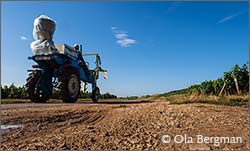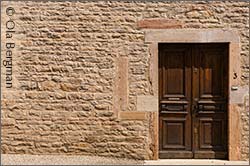
Here too there is a deft touch of wood surrounding the earthier and more sauvage-inflected aromas of black cherry and raspberry. The fleshy and delicious medium-bodied flavors possess a relatively refined mouthfeel thanks to the fine grained tannins shaping the sneaky long finale. Lovely.
– Allen Meadows, Burghound.com, Score: 88-91
The Producer

hree decades ago Domaine Bachelet in Gevrey-Chambertin was a tiny estate. Since then it has more than doubled in size, but with its 4.3 hectares it is still small.
– When I was 16 years old my father asked me if I wanted to become a winemaker, says Denis Bachelet. ”Why not?” I said. I arrived at the wine school in Beaune with a Belgian accent. After three years of studies I started working at the domaine.
Denis Bachelet’s father had decided not to continue with the family tradition of making wine in Gevrey-Chambertin. Instead he chose Belgium and the chemical industry in the 1960’s.
 – My grandmother was very pleased to see me return to Burgundy and the domaine, says Denis Bachelet. I would consult her up until two years ago, when she passed away, 97 years old.
– My grandmother was very pleased to see me return to Burgundy and the domaine, says Denis Bachelet. I would consult her up until two years ago, when she passed away, 97 years old.
When Denis Bachelet took on the domaine in 1983 it covered just 1.8 hectares. Not much, but what there was, was prime land – grand cru in Charmes-Chambertin, a bit of Gevrey-Chambertin on both village and premier cru level and one parcel in the regional Bourgogne appellation. All planted with old vines.
But since his grandparents had retired in 1973 everything had to be built up from scratch again. There was no cellar, no equipment.
– The beginning was really difficult, says Denis Bachelet. It was difficult to make a living off 1.8 hectares, so it was important to buy more vines quickly. I was lucky to meet Becky Wasserman at Le Serbet just when she started exporting wine from Burgundy. Wednesday afternoons after school I would bring my very first samples of my wines to her for tasting. She would introduce my wines to people like Clive Coates, Hugh Johnson and Jancis Robinson.
 The most recent acquisitions were in 2011 when more Côte de Nuits-Villages and Gevrey-Chambertin Les Evocelles were added to the domaine.
The most recent acquisitions were in 2011 when more Côte de Nuits-Villages and Gevrey-Chambertin Les Evocelles were added to the domaine.
– There is not much available, says Denis Bachelet. So when there is, you have to have the information before your neighbours. You have to move fast and you can’t be choosy. For Les Evocelles I received a phone call at 4 pm. At 5 pm I had bought the parcel.
– My son Nicolas joined me in 2008, so we needed some more land. We might grow a bit more, but not much.
Les Evocelles is located in Brochon, the village immediately to the north of Gevrey-Chambertin. Roughly half of Brochon is entitled to the Gevrey-Chambertin. The rest is Côte de Nuits-Villages. In old French evocelles means quarry; the lieu-dit itself is at the top of the slope, bordering on the Gevrey-Chambertin premier cru Champeaux.
 While Les Evocelles is bottled separately there is also the Gevrey-Chambertin Vieilles Vignes, a blend of several parcels around Gevrey-Chambertin. The average age of the vines is high, between 75 and 80 years.
While Les Evocelles is bottled separately there is also the Gevrey-Chambertin Vieilles Vignes, a blend of several parcels around Gevrey-Chambertin. The average age of the vines is high, between 75 and 80 years.
– We replace dead vines every year, explains Denis Bachelet. For the whole domaine it is about 600 vines every year. We try to keep the old vines as long as possible. The grapes they produce are very small. It is the same every year.
– For the vieilles vignes cuvée a large part comes from En Dérée, north of the village. Then there are also vines in Sylvie, Les Jeunes Rois, La Burie and La Justice. En Dérée has lighter soil. La Burie has a bit more clay and La Justice more sand. Depending on the weather conditions different parcels are the best in different vintages. If it is dry La Justice is difficult, because it drains too quickly. On the other hand, with more rain you always have lots of success there. You need to have different types of soil in order to have a balanced cuvée.
 Les Corbeaux, the Gevrey-Chambertin premier cru, is just outside the village, on the south side where all the grand crus are located. Domaine Bachelet have three parcels here, two of which are at the top.
Les Corbeaux, the Gevrey-Chambertin premier cru, is just outside the village, on the south side where all the grand crus are located. Domaine Bachelet have three parcels here, two of which are at the top.
– Les Corbeaux is right next to Mazis-Chambertin. Just above Les Corbeaux you have the premier cru Fonteny, which in old French means spring. In the past there was a small stream there, but it has been drained since. There is still water in the ground, which in dry years like 2005 can be very helpful for the vines and you can make great wines under these conditions. In wetter years you have to be careful.
On grand cru level there is 0.433 hectares of Charmes-Chambertin. The whole of Charmes-Chambertin covers 28.97 hectares. At Domaine Bachelet the Charmes-Chambertin sees one third new oak, one third of barrels used previously for one wine and one third used for two wines. This is the same for the premier cru and the Gevrey-Chambertin village wines. The Côte de Nuits-Villages only sees one quarter of new oak.
– We have two parcels of Charmes-Chambertin. One where we have Bernard Dugat, Claude Dugat and Perrot-Minot as neighbours and one where we have Roty and Raphet as neighbours. It is the best part of Charmes-Chambertin. Right between the two villages, Gevrey-Chambertin and Morey-Saint-Denis, you have a small hill, we are just on top of that.
 At Domaine Bachelet the work is conducted along the lines of lutte raisonnée, sustainable viticulture.
At Domaine Bachelet the work is conducted along the lines of lutte raisonnée, sustainable viticulture.
– Just after the vinification we do the first pruning, says Denis Bachelet. We keep only two canes. We plough the soil with the tractor. Partly to put the soil up against the vines in order to protect them from the cold during the winter and partly in order to cut off the roots closest to the surface. If you cut the top roots you force the vines to use the deep roots, which bring the maximum out of the soil for the grapes.
Both concrete and stainless steel vats are used at the domaine. There is a cold maceration for three to six days, depending on the vintage.
– Sometimes we use some dry ice to protect the top of the juice, says Denis Bachelet. When the fermentation has started we control the temperature, max 32-33°C. After six days of fermentation, followed by three or four days of rest we press using a pneumatic press. When the juice is in the barrels we immediately cool it to 13°C. By doing this the malolactic fermentation will not start until the following summer.
– We like to have the malolactic fermentation as late as possible. In May, June or July. In some cases even in August. By doing that you keep a high level of CO2 all the way until the bottling and it preserves the freshness of the wine.
© 2013 Ola Bergman





